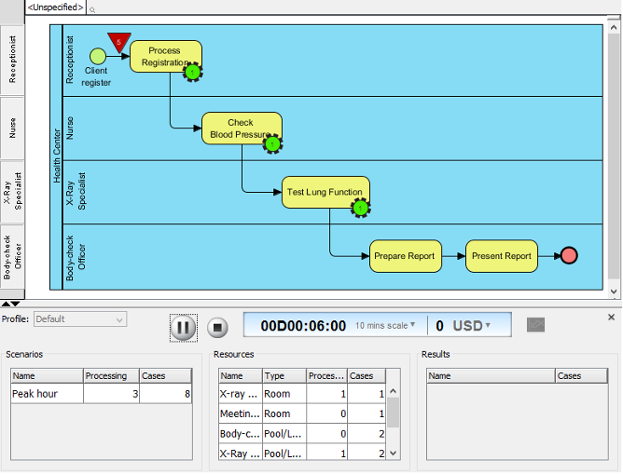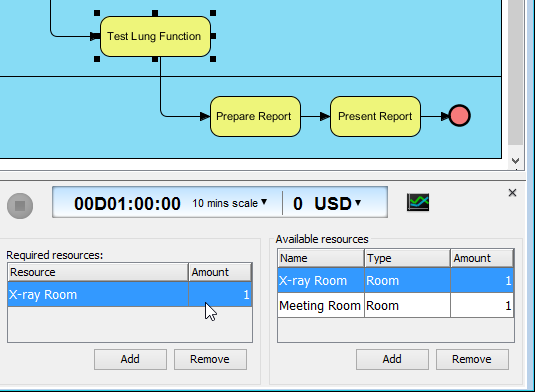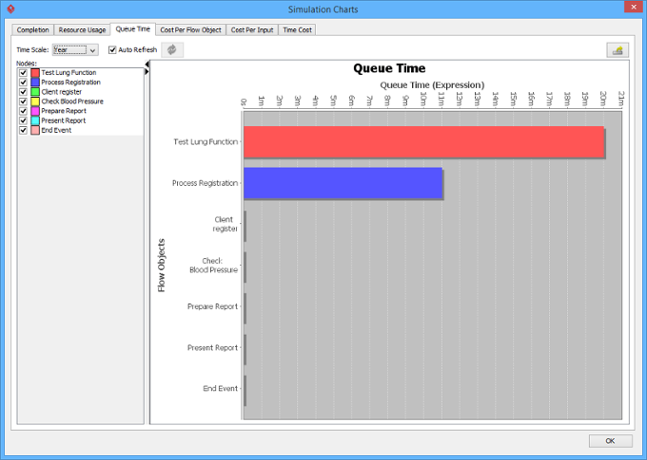What is Business Process Simulation?
The objective of performing business process modeling is to facilitate the communication with stakeholders to perform cost and benefit analysis and to perform process improvement, etc. Simulation is a set of value-added tools designed to aid business process modeling. With simulacian, you can simulate the execution of business process for studying the resource consumption (e.g. human resources, devices, etc.) throughout a process, identifying bottlenecks, quantifying the differences between improvement options which helps study and execute process improvements.
 |
| Simulating a business process |
Key concepts
Resources
Resources refer to any kind and form of input essential for the execution of a process. Each resource has three properties - name, type and amount. There are two types of resources - available resources and required resources. Available resources refer to the resources that can be used by business process but may not be fully used. For example, a post office has 10 counters as resources but only 3 are in used at peak hours. Required resources is a flow object wide option. You can set the resource and the amount of resource required by completing a flow object. For example, task Answering Enquiry requires 1 counter as resource.
 |
| Required and available resources |
Very often, the allocation of resource is critical to the efficiency of a business process. For example, if there are more available staffs and counters, this helps to increase the efficiency of customer service. But of course, if the available staffs and counters are more than enough, those non-used resources are wasted. With simulacian, you can determine the optimal resource allocation by evaluating the resource consumption of current process.
Duration
Duration is the time elapsed from the entering of flow object until the leaving of that flow object. It is understandably that the duration of flow object has significant effect to the efficiency of a business process. Imagine if it takes 5 minutes to complete the process of just one payment in a supermarket, a long queue will be acculumated to wait for trancation.
Input
Input is a way of simulating a given business process. It has a name that describe the input and an instance, which is a number that represents the number of time the input will happen at a particular instant. If you have modeled a general order processing system, you can add an input public holiday with instance 100 to represent the case that in public holiday, there will be 100 customers that need to undergo payment. In order to help you to improve your process, you must set input that reflects the reality. If you set 10000 as instance of input public holiday which will never happen, you will not obtain useful information to aid in process improvement.
Simulation
Once you have specified the available and required resources, the duration of flow objects and added input(s), you can run simulation. During simulation, diagram will be locked to avoid collision between your edit action and the simulation operation. Executing jobs are represented by a running green gear shape, with a number indicating the number of running job and are attached to the task where the job is being processed. Pending jobs are represented by inverted triangles, with a number indicating the number of pending jobs.
 |
| Executing and pending jobs |
Performance analysis through charts
During simulation of business process, you can identify the bottleneck(s) by observing the occurrence of pending jobs (i.e. the inverted triangle). This works well in a relatively small process. However, if your business process diagram is large, you may not be able to study the simulacian outcome just by observation because the simulcian can be lengthy and involve several bottlenecks. Furthermore, you may want to know the exact figure of resource consumption for conducting a more accurate resource re-allocation plan. In those cases, you can produce simulacian charts that documents the completion of inputs, resource usage and queue time of flow objects against time.
 |
| Queue Time Chart |
| Chapter 1. Process Simulation | Table of Contents | 2. Simulation control panel |
